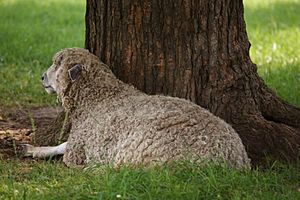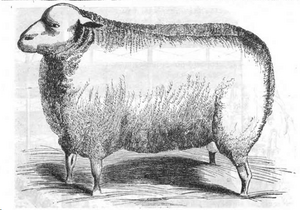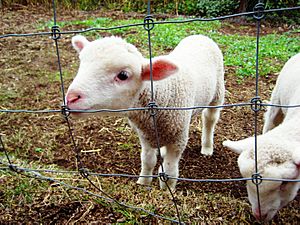Leicester Longwool facts for kids

The Leicester Longwool is a special type of sheep that comes from England. You might also hear it called by other names like English Leicester or New Leicester. This breed was first created in the 1700s by a clever farmer named Robert Bakewell.
Today, the Leicester Longwool is quite rare. In the United Kingdom, there are fewer than 500 female sheep of this breed left. Because of this, it's listed as "endangered" by the Rare Breeds Survival Trust.
Contents
History of the Leicester Longwool
Leicester Longwool sheep have a long history, going back to the 1700s. They were first developed in a place called Dishley Grange in Leicestershire, England. A farmer named Robert Bakewell was the person who created them. He was very good at choosing the best animals to breed, which helped make farm animals better.
In the 1700s, these sheep grew slowly and had heavy bones. But over time, they were bred to grow faster and gain weight quickly. The Leicester Longwool was one of the first pure sheep breeds brought to Australia in 1826. This breed has been used to improve many other sheep breeds. This is because they have a good amount of meat (called a carcass) and a lot of heavy fleece.
What Makes Them Special?
A Leicester Longwool sheep has a head that sits nicely, not too high. Their forehead, called the poll, should not have any signs of horns. Their face often looks like a wedge shape and is covered in white hair. Sometimes, their face can even look a little blue! Their lips and nostrils should be black. It's okay if they have small black spots on their face and ears.
Their neck should be a medium length. Their shoulders should be strong and level with their back, which should be flat. Their legs should be straight and wide apart, and their hooves should be black.
Their Wool
The wool of a Leicester Longwool is very dense, meaning it's thick and clumpy. These clumps are called staples. The wool should also be lustrous, which means it has a nice shine. It should have a clear wave pattern, called a crimp, from the skin to the tip of the wool. The thickness of a single wool fiber from a Leicester Longwool is usually about 32 to 38 micrometers.
Movement and Temperament
When a Leicester Longwool moves, it should look free, active, and well-balanced. They should appear alert and robust, showing a lot of style and character. They are known for having good temperaments, meaning they are generally calm and easy to handle.
Where Are They Found Today?
Leicester Longwool sheep can be found in several countries around the world. These include Australia, New Zealand, Great Britain, Sweden, and the United States. They have strong feet, which means they can live well on flat land, hilly areas, or even less fertile land. They are large sheep with wide, even backs and strong bodies.



